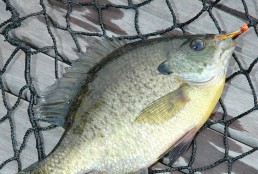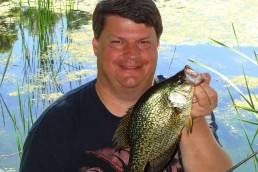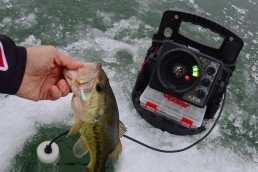Ice Fishing a Hot Tactic for Big Summer Panfish
SHARE THIS POST
Try chillin’ when the temperatures sizzle during the heat of summer. Ice fishing tactics are dynamite for bluegills and crappies, even during the peak warm months. You guessed it—the same tackle that is used in December, January and February is often a great choice for July and August.
Whether fishing a river, farm pond, lake or reservoir, many bodies of water will hold big numbers of bluegills and crappies. What’s even better, these succulent morsels are often overlooked by the majority of anglers who set their sights on casting crankbaits for bass or trolling for walleyes. And there’s nothing better than tasty panfish taking center stage at a fish fry during a Fourth of July picnic.
Hunting panfish is a favorite pursuit of ours when the mercury soars. Ted used to catch giant bluegills right from the dock in front of his house on Gull Lake near Brainerd, Minn. Fifty-fish days were common.
There are only a few modifications from ice fishing in order to adapt to open water: the rods are longer, augers are left in the garage, it’s warmer and the only thing missing is a hole.
Where to fish
The key to finding big bluegills and crappies in summer is to look for healthy green weeds, such as coontail and cabbage. Weed beds are the focus of food-chain activity because of the oxygen-rich waters and the cover they offer. Weeds can be found in rivers within low-current, backwater areas. In lakes, prime locations are inside turns of points, which reach way out to deep water.
Vegetation is well established by mid-year, and weeds often break the surface near the shore. The tops of weeds within many lakes will be submerged farther out, and sometimes down several feet. The key fish zone extends from the point the weed tops dip beneath the surface to the outside weed edge. That targeted area may stretch well into the lake depending on water clarity and the sunlight’s ability to penetrate to the bottom.
Big bluegills and crappies may also huddle close to standing timber over deeper water in lakes and reservoirs. Fish after fish can be taken, usually from the shady side, even as water skiers and jet skiers roar by. Man-made fish cribs are also great summertime magnets.
What to fish with
Equipment for the panfish is simple. Long cane poles work great, or you can use longer, lightweight spinning rods to increase the fun of the battle. St. Croix makes an awesome 11-foot panfish spinning rod that can reach right into the thick stuff and that has enough backbone to pull these feisty fighters out of the cabbage. Stick with light line here; use 2- or 4-pound-test line. Consider 6-pound line when fishing among rocks or fallen timber that might cause nicks in your line.
Are you enjoying this post?
You can be among the first to get the latest info on where to go, what to use and how to use it!
Although the nearest ice may be at the poles at this time of the year, ice jigs are still a great way to present live bait to hungry ‘gills and crappies during summer. The 1/64- or 1/32-ounce tungsten jig heads are the bomb in open water. They drop fast and vertical, yet they’re irresistible when dressed with waxworms or euro larvae, also known as “spikes” or maggots. Nightcrawler pieces or small leeches are also good picks at times. Dark, natural jig colors like black work best early in summer when the water is clear. But after temperatures warm, the algae blooms, and chartreuse, orange or high-vis. colors are best.
Unlike plain hooks, fish are usually hooked in the lip with ice jigs and rarely swallow one. That makes it easier to release ones under length limits or when culling, where legal. Choose tiny ice jigs and combine them with a lightweight Venom adjustable foam float (another ice fishing weapon). Venom floats are adjustable to a jig head of any size. Together, an ice jig and an ice float create a lethal, sensitive combination that detects the lightest of bites. Fine-tune the combination if needed by simply moving the foam up or down within the float. When adjusted correctly, the float reacts quickly when a fish takes the bait. The float can also provide the needed stealth.
There are times when fish can be caught on every cast while using wintertime methods during the summer. This can be seen in contrast to other anglers using big, round, red-and-white plastic bobbers who never had a bite—there’s just too much buoyancy. Switch your regular floats to lighter floats and you’ll start catching one after another.
The approach
Once you are properly rigged and have located a good-looking weed bed, anchor your boat to precisely control your presentation and avoid spooking fish. Minn Kota’s Talon is a shallow-water, remote-controlled anchor. Push a button and a rod drops down, instantaneously anchoring your boat to the bottom. Don’t cast your rigs at first; gently lay the float on the surface to drop the bait straight down into shallow pockets or trenches in the weeds when the sun is at its brightest. Fish begin moving out to the weed edges or the shallows in low-light conditions. Control your depth with a bobber-stop threaded on the line. The jig sinks until the float reaches the stop.
Think of each area where you make a dip of the rod as another ice hole. Let the bait rest briefly or lift and drop it to impart a jigging action to trigger strikes. Nothing? Keep moving and anchor to different parts of the weed bed, or just find another. Don’t just wait for the fish to come to you; bluegills and crappies are not bashful biters and will hit soon if they are there.
If you’re catching them and the action suddenly stops, try adjusting the depth of the jig. Fish often move up or down in the water column over the course of the day while they follow the vertical movements of the zooplankton, the tiny one-celled animals which they feed on.
Keep your baits fresh. Even conscientious anglers who commonly change minnows anytime they stop moving often leave waxworms or spikes on far too long.
Is it hot outside? Think “ice fishing” for panfish. It’s a really cool way to catch fish during the heat of the summer.
MWO
SHARE THIS POST
Did you enjoy this post?
You can be among the first to get the latest info on where to go, what to use and how to use it!
Ted Takasaki
Ted Takasaki is an International Fishing Hall of Fame professional angler who has been featured in many national outdoor magazines and television shows. Takasaki has appeared in front of thousands of angling enthusiasts and is considered one of America’s top walleye and multispecies anglers. Follow him on his Facebook page.



